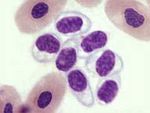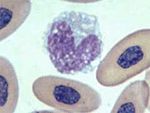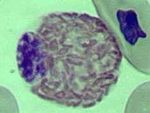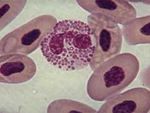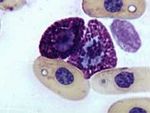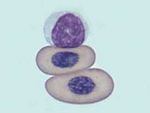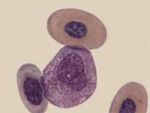Difference between revisions of "Lizard and Snake Haematology"
| Line 11: | Line 11: | ||
Identification of blood cells can be a problem due to lack of comprehensive reference material for reptile haematology, lack of standardised nomenclature for leucocytes, species variation, inappropriate anticoagulants, improper sampling technique and lymph dilution. Automated counting techniques may not be suitable for reptile blood samples because of the nucleated red blood cells. Reptile leucocytes are fragile and the proper technique in preparation of blood smears is important to obtain valid differentials. | Identification of blood cells can be a problem due to lack of comprehensive reference material for reptile haematology, lack of standardised nomenclature for leucocytes, species variation, inappropriate anticoagulants, improper sampling technique and lymph dilution. Automated counting techniques may not be suitable for reptile blood samples because of the nucleated red blood cells. Reptile leucocytes are fragile and the proper technique in preparation of blood smears is important to obtain valid differentials. | ||
| − | Blood cells include erythrocytes which are nucleated, [[Leucocytes|leucocytes]] ([[Heterophils|heterophils]], [[Eosinophils|eosinophils]], [[Basophils|basophils]], [[Lymphocytes|lymphocytes]], [[Monocytes|monocytes]] and [[Azurophils|azurophils]]) and [[Thrombocytes|thrombocytes]] | + | Blood cells include erythrocytes which are nucleated, [[Leucocytes|leucocytes]] ([[Heterophils|heterophils]], [[Eosinophils|eosinophils]], [[Basophils|basophils]], [[Lymphocytes|lymphocytes]], [[Monocytes|monocytes]] and [[Azurophils|azurophils]]) and [[Thrombocytes|thrombocytes]]. |
| − | |||
| − | |||
| − | |||
| − | |||
| − | |||
| − | |||
| − | |||
| − | |||
| − | |||
| − | |||
| − | |||
| − | |||
| − | |||
| − | |||
| − | |||
| − | |||
| − | |||
| − | |||
| − | |||
| − | |||
| − | |||
| − | |||
| − | |||
| − | |||
| − | |||
| − | |||
| − | |||
| − | |||
==Interpretation== | ==Interpretation== | ||
Revision as of 17:33, 20 March 2010
| This article is still under construction. |
Blood (plasma and cells) is approximately 6% of the body weight of snakes and the normal PCV of a snake is about 0.20 to 0.30 l/l (20-30%). Blood cells form in the bone marrow and spleen, and early in life, the liver.
Identification
Identification of blood cells can be a problem due to lack of comprehensive reference material for reptile haematology, lack of standardised nomenclature for leucocytes, species variation, inappropriate anticoagulants, improper sampling technique and lymph dilution. Automated counting techniques may not be suitable for reptile blood samples because of the nucleated red blood cells. Reptile leucocytes are fragile and the proper technique in preparation of blood smears is important to obtain valid differentials.
Blood cells include erythrocytes which are nucleated, leucocytes (heterophils, eosinophils, basophils, lymphocytes, monocytes and azurophils) and thrombocytes.
Interpretation
Blood parameters in reptiles are influenced by a wide array of variables that include species, age, sex, nutritional status, physiological status, season, environment, blood sampling technique, sample handling, use of anticoagulants and methods of staining. It is also not uncommon for blood samples to be contaminated with lymph. Therefore it is preferable to obtain a set of normal reference values for each individual reptile during times of health under known environmental and nutritional conditions. The morphology of cells may provide more information than the cell counts.
Staining
Romanowsky stains, although time consuming, give the best results. DiffQuik may give adequate results. Reticulocytes are detected with new methylene blue, brilliant cresyl blue and other supravital stains. Cell-specific stains are available.
